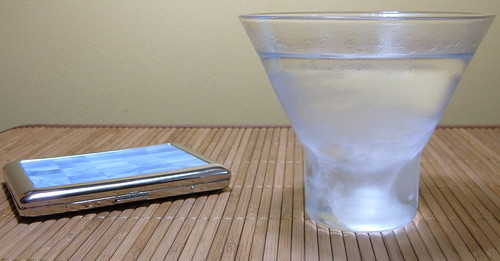Long story short, a Martini, in the classic, timeless, perfect, sublime sense of the drink, has a scant three ingredients, plus optional garnish; gin, dry vermouth, a couple dashes of orange bitters, lemon twist garnish (actually, just twist the lemon over the drink and then ditch the peel...you really only want the oils). The main variances in the experience of the martini come into play with the alteration of the gin-to-vermouth ratio and the variety of each you use.
It's very possible to take the ratio to extremes...at times, the preferred ratio was 8 parts of gin and a menacing glare at the vermouth bottle...in other words, cold gin. On the other end of the spectrum, there's equal measures of gin and vermouth, which takes it back too far away from dryness...in the end, you want the best of both worlds; you want that crisp dryness from the gin tempered ever so slightly with the more mellow aspect of the vermouth (which is still dry, but not nearly so much as the gin). To this end, I agree with David Wondrich in that an idea proportion, though a tricky one to attain without using a scale (like I do, because Alton Brown taught me well) is 7 parts gin to one part vermouth. You can get pretty much there with 2 oz gin and barely two teaspoons of vermouth, or you can just plunk your mixing glass or shaker full of cracked ice on your digital scale, pour in 63 mL of gin and 9 of vermouth, dash in your orange bitters, and stir until everything is well chilled.
I commented to my two followers on Twitter (ok, one follower, the other is my main account) that I'd procured a couple new spirits today, including Rehorst, a locally produced gin. So I figured I'd test it out in a Martini. The gin's distilled by Great Lakes Distillery, and it features, among its botanicals, two unusual elements; sweet basil (sometimes called "sacred basil") and Wisconsin ginseng. Neither of those have ever been used in a commercial gin before, and they make for a really unique aroma and taste.

This is my first time sampling Rehorst's gin, so my impressions are about as fresh as possible. It's a really really clean gin, and oddly enough, the first flavors I get from this drink are a clean hard mineral flavor and, perplexingly, coconut, and then the citrus notes come into play! It's great, though, I'm sold already. I think, on reflection, that the mineral flavor I'm getting is the sweet basil and coriander, maybe some of the ginseng. Whatever it is, mark me down as a fan. I look forward to trying this one in a Gin Rickey and a G&T, as well. If you don't live in the Midwest, see if you can order it from their website. It's a damned good gin.






0 comments:
Post a Comment